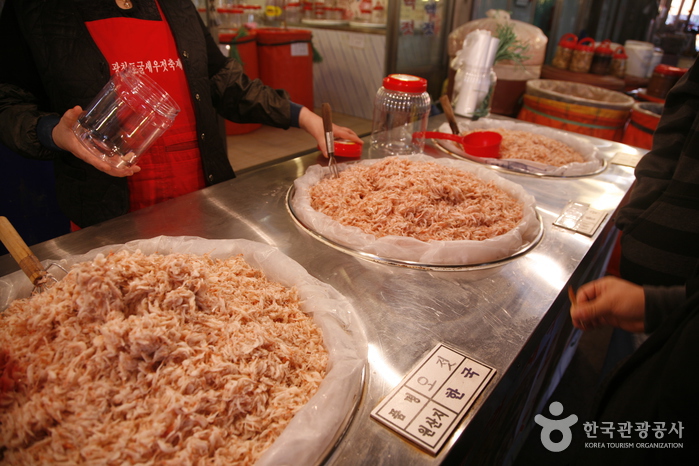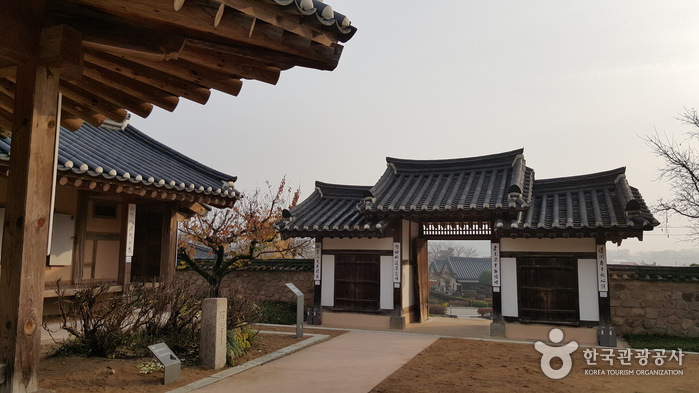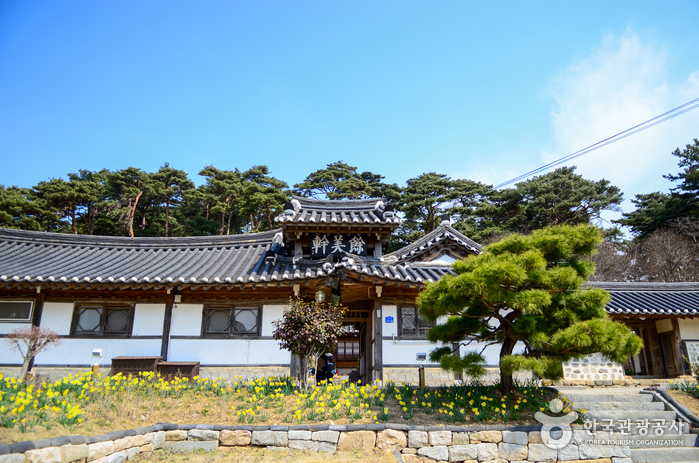Daeheung Sikdang (대흥식당)
17.5 Km 0 2024-02-21
37-1, Sudeoksaan-gil, Deoksan-myeon, Yesan-gun, Chungcheongnam-do
Daeheung Sikdang is an old restaurant that serves great sanchae (wild vegetables) cuisine at the entrance to Sudeoksa Temple, a famous Buddhist temple in Korea. Its signature menu is the dolsot deodeok jeongsik (hot stone pot rice and deodeok set menu), featuring fragrant deodeok and wild vegetable dishes prepared with care. There are other menus on offer, such as beoseot pajeon (mushroom and green onion pancake), ureong chomuchim (sweet and sour freshwater snail salad), dotori bindaetteok (acorn and mung bean pancake), dotorimuk (acorn jelly salad), and sundubu (soft bean curd). Side dishes include jogi gui (grilled yellow croaker), ori barbecue (duck barbecue), and doenjangguk (soybean paste soup).
Yesan Hwaamsa Temple (화암사 (예산)
17.9 Km 7473 2020-04-04
21-29, Yonggung 1-gil, Yesan-gun, Chungcheongnam-do
+82-41-332-9250
Hwaamsa Temple is located near Joseon dynasty's scholar and writer Kim Jeong-hui's, also referred to his pen name Chusa, house. The temple has ties with the ancient writer, as the temple is known to have been repaired and renovated by Kim Jeong-hui's great grandfather. There are no records that explains the foundation of Hwaamsa Temple, and only a timeline of its reconstruction can be found in "Records of Hwaamsa Temple Restoration" plaque, which is displayed in Sudeoksa Temple Museum. The timeline was recorded by Kim Myeong-hee in 1848, and written by Kim Seong-hee, and carved by Cho Seok-shin. The name "Hwaamsa" was given by King Yeongjo (r. 1724-1776).
Gwangcheon Cave Salted Shrimp Market (광천 토굴새우젓시장)
18.0 Km 23897 2024-02-26
8-20, Gwangcheon-ro 285beon-gil, Gwangcheon-eup, Hongseong-gun, Chungcheongnam-do
Gwangcheon Cave Salted Shrimp Market is a traditional market located in Gwangcheon, between Hongseong and Boryeong. Gwangcheon’s proximity to the Yellow Sea makes it a famous place for jeotgal (salted seafood), made using seafood and shrimp caught from the Yellow Sea, and laver seaweed. Gwangcheon’s saeujeot (salted shrimp) is stored and aged in a cave tunnel, so it has great quality. The market also offers agricultural goods, seafood, clothing, and sundry items.
House and Tomb of Kim Jeong-hui (추사김정희선생고택·묘)
18.2 Km 20028 2024-02-21
261, Chusagotaek-ro, Sinam-myeon, Yesan-gun, Chungcheongnam-do
This house and tomb are where Kim Jeong-hui (pen name: Chusa, 1786-1856), a Joseon-era scholar and artist, lived and was laid to rest. Chusa Memorial Hall and Chusa Experience Center are found next to the house. After studying in Qing China, Kim Jeong-hui served in multiple government posts. He is best known for his unique calligraphical style, which bears his courtesy name (Chusa), and many works of art that survive to this day. The Experience Center offers traditional art experiences inspired by Kim Jeong-hui’s works.
House of Chusa (추사고택)
18.3 Km 14764 2022-12-28
261, Chusagotaek-ro, Yesan-gun, Chungcheongnam-do
+82-41-339-8248
House of Chusa, Chusa Gotaek in Korean, is the traditional Korean house of the renowned scholar and calligrapher Chusa, also known as Kim Jeong-hui. This old house is known to have been constructed by the great-grandfather of Chusa, Kim Han-Sin.
The Korean-style house compound (266.11 m²) consists of munganchae (a guesthouse), soseuldaemun (a high gate), sarangchae (ㄱ-shaped men's quarters), anchae (ㅁ-shaped women’s quarters) and a shrine where the remains of Chusa are enshrined. Theㄱ-shaped Sarangchae stretches for one kan (traditional measuring unit) to the south and 2 kans to the east and is comprised of two rooms and a daecheongmaru (living area). The Anchae consists of a six-kan daecheongmaru and two one-kan rooms.
Located on the ground is a tomb where Chusa’s great-grandfather (Kim Han-Sin) and his wife (Hwasun Princess) are buried. Nearby, visitors will see a gate that was constructed to commemorate Princess Hwasun’s faithfulness to her husband.
Located approximately 600 meters to the north of the old house is a lacebark pine tree, which was designated as a Natural Monument. The lacebark pine tree, originally from northern China, is among the few of its kind in Korea. It is said that Chusa snuck the pine across the border from China (formerly, the Qing dynasty) into the country when he was 25 years old and planted it at the tomb of his great-grandfather. Originally, the tree had three branches, but two were broken and the third branch was damaged. In 1980, the damaged branch was treated and since then, the tree has been kept under strong protection.
Seosan House of Yu Gibang (서산 유기방가옥)
18.5 Km 30870 2024-03-11
72-10 Imunan-gil, Seosan-si, Chungcheongnam-do
House of Yu Gibang was built in the early 1900s and measures 4,770㎡. As a valuable historical asset, it was designated as a Chungcheongnam-do Folk Culture Heritage on October 31, 2005. The house faces south on a low mountain with a thick pine forest background. A courtyard is at the center of the house, created by the straight line-shaped anchae to the north, the haengnangchae to the west, and a chat room with anchae to the east. Initially, there was a middle gate in front of the anchae, but it was demolished in 1988 and replaced with a pavilion-shaped gate as seen now.
E-Mart - Seosan Branch [Tax Refund Shop] (이마트 서산)
18.9 Km 0 2024-04-22
3685, Seohae-ro, Seosan-si, Chungcheongnam-do
-
Himart - Seosan Branch [Tax Refund Shop] (하이마트 서산점)
19.1 Km 0 2024-04-22
3374, Seohae-ro, Seosan-si, Chungcheongnam-do
-
Seosan Kkotgejang (서산꽃게장)
19.1 Km 21041 2024-03-04
92 Hanmaeum 5-ro, Seosan-si, Chungcheongnam-do
041-665-8829
Seosan Kkotgejang specializes in preparing blue crabs harvested from the Seohae Coast using traditional methods. They offer both ganjang kkotgejang (soy sauce marinated blue crab) and yangnyeom kkotgejang (spicy marinated blue crab). The ganjang kkotgejang is prepared by marinating fresh crabs with ginger, garlic, soy sauce, and other seasonings, resulting in a savory and flavorful taste. The yangnyeom kkotgejang is marinated with a seasoning mixture primarily consisting of chili pepper powder. They also serve dishes like ureok jeotguk (salted rockfish soup) and yeongyang gulbap (nutritious oyster rice). Seosan is known for its bay, providing an ideal habitat for blue crabs.
Hongseong Namdanghang Port Jumbo Shrimp Festival (홍성 남당항 대하축제)
19.1 Km 26270 2022-11-11
213-1, Namdanghang-ro, Hongseong-gun, Chungcheongnam-do
• 1330 Travel Hotline: +82-2-1330 (Korean, English, Japanese, Chinese) • For more info: +82-10-3288-9551
Namdanghang Port, located at the west end of Hongseong, is a famous west coast port known for its exceptional seafood. Surrounded by the clean waters of Cheonsuman Bay, Namdahang Port is home to a wide array of sea life including blue crab, cockle and webfoot octopus. Namdanghang Port also draws throngs of visitors from early September to mid-October every year for the country’s largest Jumbo Shrimp Festival.




![E-Mart - Seosan Branch [Tax Refund Shop] (이마트 서산)](http://tong.visitkorea.or.kr/cms/resource/24/2883324_image2_1.jpg)
![Himart - Seosan Branch [Tax Refund Shop] (하이마트 서산점)](http://tong.visitkorea.or.kr/cms/resource/33/2883333_image2_1.jpg)
 English
English
 한국어
한국어 日本語
日本語 中文(简体)
中文(简体) Deutsch
Deutsch Français
Français Español
Español Русский
Русский